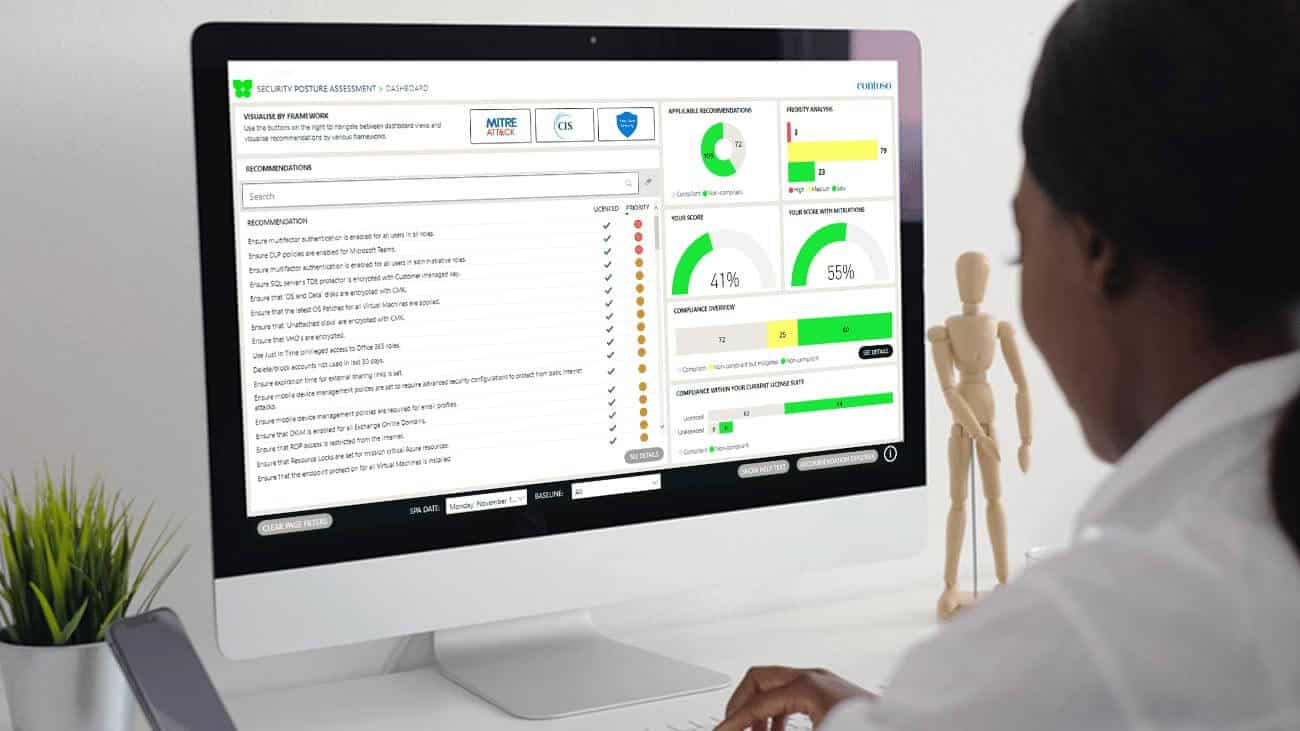While business leaders are increasingly aware of the threat posed from cyber attacks, too many are still taking chances with their security posture. Which puts their organisation at risk.
Awareness to the severity and relentless nature of cyber threats has grown among business leaders in the past few years. Indeed, recent studies have shown that it’s now among the leading concerns of CEOs and investors.
But the digital landscape of the modern organisation is a complex place.
And while leaders may acknowledge the abstract threat, many are reluctant to take ownership of the issue. Remaining oblivious to the myriad of dangers lurking within their systems.
Security blind spots that, left unchecked, could wreak havoc on a business’ reputation, finances, and stability.
In this article, we take a look at common vulnerabilities that you should be aware of.
And, why maintaining vigilance and a strong security posture is vital for the future of your business.
Are you at risk from misconfiguration?
According to VERIS, an open-source project for recording security events and incidents, misconfiguration accounts for 35% of all cyber breaches.
Now, figures may vary from one report to the next, but the fact remains: Misconfiguration is a big deal.
If you have misconfigured settings within your system or applications, then your entire network is vulnerable to attack. Which drives up the risk in your business.
Common types of misconfigurations include:
- Default settings: Are you using devices, applications or programmes where the settings have never been altered from the default set-up? Then you might be exposing yourself to risk. Hackers will be savvy to these settings and can target them as a potential weak spot.
- Weak password policies: If you’re using weak passwords (or, heaven forbid, the default system password), then you’re putting a target on your back.
- Poor access controls: Outdated or unused user accounts, or access permissions that are no longer required can be a major weak spot in your defences. Bad actors can target these accounts and use them to gain access, steal data, or inflict untold damage through malware attacks.
- Outdated software: Updates and patching are there for a reason. If you’re not updating or patching the software, or still using older or obsolete versions, then you’re creating a serious vulnerability that hackers will gleefully exploit.
- Data protection flaws: Implementing data loss prevention measures is an essential part of your security makeup. But, if this is misconfigured you risk data falling into the wrong hands. And data breaches come with some severe financial, reputational, and legal consequences.
Misconfigurations are frequently happy hunting grounds for cyber predators, looking for weaknesses to exploit.
Exposing your business to costly data loss, disruption of service and other malicious activity that can compromise your integrity and cost you dearly.
Managing and monitoring configurations should be an essential part of your ongoing processes. That’s why it’s vital that you carry out regular reviews, assessments, and maintenance.
And, always stay on top of your software updates.

Watch 3-minute Security Posture Assessment Demo
See for yourself how a Security Posture Assessment helps you:
- Improve visibility of security threats
- Prioritise threats based on risk and effort
- Track improvements and measure ROI
- Stop wasting money with smarter investments
Don’t neglect the human threat
Whether through accident or malice, human beings are a significant security threat. According to a Verizon report in 2022, 82% of all data breaches were a direct result of human error (or similar misdeed).
Human-based weak spots will typically be a result of:
- Lack of understanding or required skills.
- Lapses in judgement or ‘taking their eye off the ball’.
- Inadequate training and security awareness.
- Disregard of policies and processes.
- Malicious intent.
A common example of a human action leading to a serious issue is when a member of the workforce falls foul of a phishing email.
A hugely prevalent tactic of cyber criminals, phishing threats can be extremely harmful when they succeed.
Shoring up the defences here is a classic example of how behaviour and technology can work together.
All employees should be trained on diligence and spotting suspicious emails. However, as phishing scams grow more convincing in the age of AI, you need cyber threat detection technology that can keep pace.
The shadow IT issue: Get to grips with every app in your organisation
Don’t let your cloud-services become a free-for-all. Shadow IT, third-party apps, and unauthorised software can pose a significant security risk to your business. This can happen if employees are able to install apps, SaaS solutions, or similar, without going through the proper channels.
It opens up a whole world of vulnerability and can seriously undermine your overall security posture.
It’s essential to have clear policies in place for the use of third-party apps and to ensure that all software is authorised and up to date.
Therefore, establishing a clear policy around cloud services is essential when it comes to the use of third-party apps. Ensuring all software is verified and up to date.
Plus, by implementing tools such as Microsoft Defender for Cloud Apps you can manage your suite of apps effectively. While also having robust, automated detection and response against attacks.
Endpoint and mobile risks in a remote or hybrid workforce
The modern workplace is flexible. Workers blend their time between the office, home, and all points in between. And, the number of laptops, tablets, and mobile devices in use and accessing systems has soared.
It’s a trend that’s unlikely to reverse any time soon.
Which means: threats that exist beyond the traditional perimeters of our organisations. Especially in environments where employees may be using their own personal devices.
When considering endpoint and mobile security, and potential blind spots, you need to ask:
- Do you know of every device that has access to company data and resources?
- Do all devices have appropriate threat protection in place against malware or ransomware?
- Can data be secured on devices in the event they’re lost or stolen?
- Are your devices vulnerable to hacking when operating on public networks (e.g. coffee shop Wi-Fi)?
- Is every device using appropriate multi-factor authentication (MFA)?
- Can you prevent corporate and sensitive data leaking outside your network?
Each of these scenarios presents a serious risk to your business. So, not only do you need to know the answer to these questions, it’s also imperative that you have adequate policies and effective device and endpoint management controls in place to mitigate the risks.
A strong security posture gives greater visibility and peace of mind
Every workplace is a unique and varied environment.
Different devices, locations, people, or technology needs.
And, the stark reality is that every variation comes with a risk. Cyber criminals are looking for weaknesses to exploit. Searching the far corners of your network, eking out the blind spots that can leave your business vulnerable.
But, by getting full visibility over your digital estate you can see where you’re strong, and where there’s need for improvement.
This is where the values lies when investing in a security posture assessment (SPA).
It gives you the insight to make the right decisions on your security investments. To identify where you’re vulnerable so you can take the appropriate action.
Greater security intelligence, helping you make smarter, more cost-effective decisions.
Deploying the tools you need to keep your defences strong, and help you sleep a little easier at night.
Key takeaways
While business leaders understand the importance of cyber security, many are still not doing enough.
Assessing configurations and controlling third-party apps is essential in mitigating weak spots.
Blending policy with the right technology plays a vital role in overcoming risk from human frailty.
It’s business critical to understand and protect against endpoint and mobile device risks.
A security posture assessment gives visibility to vulnerabilities for smarter investments.

Watch 3-minute Security Posture Assessment Demo
See for yourself how a Security Posture Assessment helps you:
- Improve visibility of security threats
- Prioritise threats based on risk and effort
- Track improvements and measure ROI
- Stop wasting money with smarter investments

Great emails start here
Sign up for free resources and exclusive invites
Subscribe to the Kocho mailing list if you want:
- Demos of the latest Microsoft tech
- Invites to exclusive events and webinars
- Resources that make your job easier

Don't Miss
Great security & compliance resources

Cybersecurity a year in review: What happened in 2025, and what it means for your 2026 security strategy

How to achieve cost-effective threat visibility with Microsoft Sentinel data lake

Turn your people from phishing fodder to the first line of defence

Choosing the right SIEM: Microsoft Sentinel vs Splunk vs QRadar
























Got a question? Need more information?
Our expert team is here to help.




